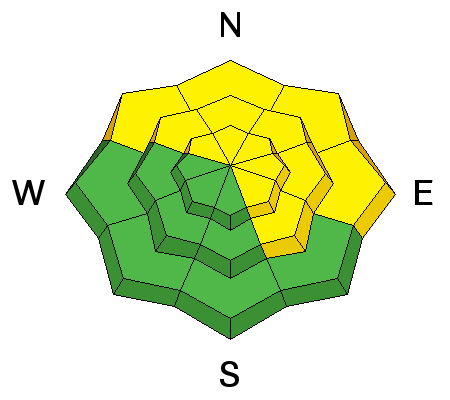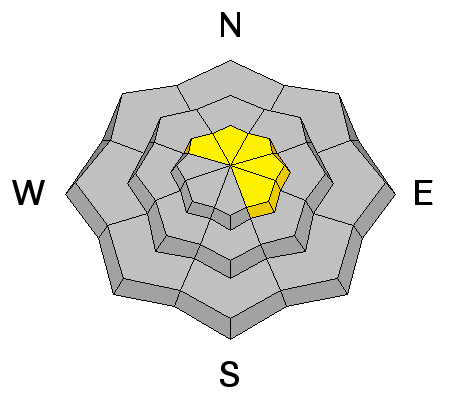25th Annual Black Diamond Fall Fundraising Party
Thursday, September 13; 6:00-10:00 PM; Black Diamond Parking Lot

25th Annual Black Diamond Fall Fundraising Party
Thursday, September 13; 6:00-10:00 PM; Black Diamond Parking Lot
| Advisory: Uintas Area Mountains | Issued by Craig Gordon for Thursday - February 2, 2017 - 3:49am |
|---|
 |
special announcement Do you buy groceries at Smiths? When you register your Smith’s rewards card with their Community Rewards program, they will donate to the Utah Avalanche Center whenever you make a purchase. It's easy, only takes a minute, and doesn't cost you anything. Details here.
Also... if you're at the Nobletts Trailhead, make sure to swing by the beacon checker at the south end of the parking lot and take a minute to practice your rescue skills at Beacon Basin on the northeast side. These are the types of projects your generous donations help fund and maintain. And finally...we still have a few spots open for our February 9th and 11th sled specific avy and riding skills work shop. Details are found here. |
 |
current conditions A weak storm system is sliding through the region, giving us high clouds, continued southwest winds in the 20's and 30's, and temperatures in the upper teens and low 20's. Our surface snow is tired and many popular riding areas are tracked out. However, with a little effort, you'll still find patches of dense, creamy powder.
Real time wind, snow, and temperatures for the Uinta's are found here
I connected with JG and Dave Kikkert in Upper Weber Canyon Tuesday. Where we were digging, we found the snowpack to be well-behaved and unreactive to snowpit stability tests. (JG photo) Snowpack observations and trip reports are found here. |
 |
recent activity
No new avalanche activity since late last weekend. This slide above was remotely triggered from about 60 feet away near Hoyt Peak on Sunday. Breaking 16" deep and about 175' wide and failing on well preserved Surface Hoar, this avalanche exemplifies the type of avalanche dragon we're dealing with. More details found here. (Provo photo) A full list of Uinta avalanche activity is found here. |
| type | aspect/elevation | characteristics |
|---|


|


|

LIKELIHOOD
 LIKELY
UNLIKELY
SIZE
 LARGE
SMALL
TREND
 INCREASING DANGER
SAME
DECREASING DANGER
|
|
description
This is where it gets tricky and a bit counter-intuitive. Our unpredictable and unmanageable avalanche problem is mostly confined to wind sheltered terrain facing the north half of the compass where a fragile layer of surface hoar and weak, sugary, near surface facets were preserved and buried prior to the big January storm cycle. Suspect terrain includes mid and low elevation creek bottoms and terrain features where cold air pools. These layers are hard to detect unless we spend a little time and dig into the snow to investigate. Notoriously tricky and persistent, these weak layers are now buried a couple feet deep in our snowpack and until recently, have been pretty well-behaved. However, now that the storm snow is starting to consolidate and settle, the dormant layers are coming back to life. It's a deceptive setup for sure, but it doesn't have to be a roll of the dice and the solution is easy. With a little homework, by simply digging around you can easily identify slopes that have a suspect snowpack and develop a trend, along with a strategy to avoid slopes with this problematic layering. Remember- any avalanche that breaks into weak layers buried deep in the snowpack will be dangerous.
With a little bit of homework you can clearly identify the weak layer now buried about a foot or so from the snow surface. |
| type | aspect/elevation | characteristics |
|---|


|


|

LIKELIHOOD
 LIKELY
UNLIKELY
SIZE
 LARGE
SMALL
TREND
 INCREASING DANGER
SAME
DECREASING DANGER
|
|
description
Found along the leeward side of mid and upper elevation ridges and around terrain features like chutes and gullies, todays slabs are stubborn and feel welded in place. However, once triggered any avalanche can grow into a bigger problem if it breaks into weaker snow now buried several feet deep in the snowpack. Your best strategy is to simply avoid fat looking, rounded pillows of snow, especially if they feel or sound hollow like a drum.
|
 |
weather A weak weather system crosses the area today through this evening, producing little in the way of snowfall. Skies will be mostly cloudy with temperatures climbing into the low 30's. West and southwest winds blow in the 30's along the ridges. A somewhat stronger, but not very cold storm system affects the area late Friday through Saturday. |
| general announcements Remember your information can save lives. If you see anything we should know about, please participate in the creation of our own community avalanche advisory by submitting snow and avalanche conditions. You can call me directly at 801-231-2170, email [email protected] The information in this advisory is from the US Forest Service which is solely responsible for its content. This advisory describes general avalanche conditions and local variations always occur. The information in this advisory expires 24 hours after the date and time posted, but will be updated by 7:00 AM on Friday February 3rd. |